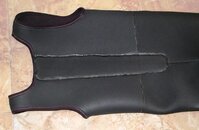Earlier this year I finally went on my first tropical liveaboard. I was a warm water newbie except for a week of diving with a T-shirt and trunks about 40 years ago. This was also my first liveaboard that didn’t require steel-toe shoes and a hard hat on deck.
Off-the-rack suits never fit me well. Since using one of my 7mm suits wouldn’t cut it, I looked into a custom 3mm. Custom gave me a blank slate to try whatever I wanted. The evolution went something like this:
I have always preferred wetsuits with Nylon lining on the outside only. Nylon-1 is more flexible, reduces water circulation, and is less abrasive against waterlogged skin. The disadvantage is they are harder to don; nearly impossible without a lubricant. We used corn-starch or baby powder as a lubricant in the old days. However, things have changed.
The diluted soap spray that modern freedivers use makes these suits so slippery they are effortless to don. The best part is you don’t care if the inside of the suit dries or not… ever struggle to put on a damp wetsuit with Nylon? Complete drying is a problem when splashing every few hours.
I have had terrible luck with zippers over the years. They are much better today but still fail, and always at the worst possible time. My simple-minded solution is no zippers. I am comfortable diving two-piece freediving suits with a farmer-john and pull-over jacket. The two changes I wanted were a mock turtleneck instead of an attached hood and Scuba rather than freediving material (for better long-term compression resistance).
All the custom suit makers I spoke with were convinced I would not be happy with this suit and figured I would be back for a Nylon-2 one-piece back-zip 3mm suit before my next trip. I ordered it anyway. My new suit arrived and fit perfectly.
Easy donning was important because liveaboard diving means donning wetsuits 4-5 times/day for a week. My one complaint was pulling the jacket down over the external Nylon lining on the farmer-john pants was a struggle. I planned to live with it but the problem continued to bug me. I found that even damp Nylon lining slid pretty well on another layer of Nylon so I had the jacket modified with Nylon-2 on the bottom part of the jacket that contacts the farmer.
I am gearing up for my second tropical liveaboard early next year and can’t think of anything to improve on this suit (which is an anomaly for me). These photos are of the inside, front and back.
Off-the-rack suits never fit me well. Since using one of my 7mm suits wouldn’t cut it, I looked into a custom 3mm. Custom gave me a blank slate to try whatever I wanted. The evolution went something like this:
I have always preferred wetsuits with Nylon lining on the outside only. Nylon-1 is more flexible, reduces water circulation, and is less abrasive against waterlogged skin. The disadvantage is they are harder to don; nearly impossible without a lubricant. We used corn-starch or baby powder as a lubricant in the old days. However, things have changed.
The diluted soap spray that modern freedivers use makes these suits so slippery they are effortless to don. The best part is you don’t care if the inside of the suit dries or not… ever struggle to put on a damp wetsuit with Nylon? Complete drying is a problem when splashing every few hours.
I have had terrible luck with zippers over the years. They are much better today but still fail, and always at the worst possible time. My simple-minded solution is no zippers. I am comfortable diving two-piece freediving suits with a farmer-john and pull-over jacket. The two changes I wanted were a mock turtleneck instead of an attached hood and Scuba rather than freediving material (for better long-term compression resistance).
All the custom suit makers I spoke with were convinced I would not be happy with this suit and figured I would be back for a Nylon-2 one-piece back-zip 3mm suit before my next trip. I ordered it anyway. My new suit arrived and fit perfectly.
Easy donning was important because liveaboard diving means donning wetsuits 4-5 times/day for a week. My one complaint was pulling the jacket down over the external Nylon lining on the farmer-john pants was a struggle. I planned to live with it but the problem continued to bug me. I found that even damp Nylon lining slid pretty well on another layer of Nylon so I had the jacket modified with Nylon-2 on the bottom part of the jacket that contacts the farmer.
I am gearing up for my second tropical liveaboard early next year and can’t think of anything to improve on this suit (which is an anomaly for me). These photos are of the inside, front and back.






